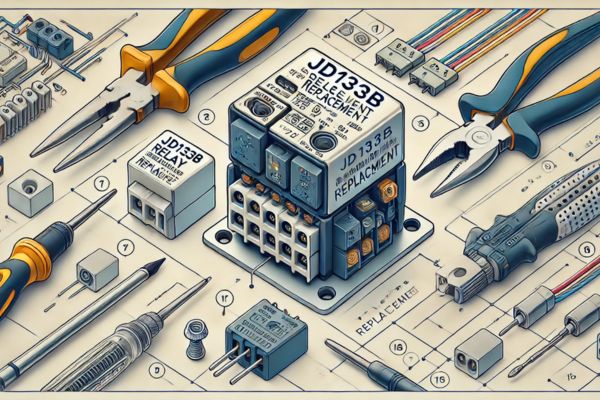Relays play a crucial role in various electrical systems, and the “jd133b relay” is no exception. When a relay like the jd133b begins to malfunction, a replacement becomes essential to ensure the proper functioning of the system it supports. This detailed guide covers all aspects of “jd133b relay replacement,” from understanding its purpose to step-by-step instructions for replacing it effectively.
What is a “jd133b Relay Replacement”?
A “jd133b relay replacement” involves the process of removing a faulty jd133b relay and installing a new one to restore system functionality. Relays, including the jd133b model, act as electrical switches that control circuits using low-power signals. They are vital in many applications, from automotive systems to industrial machinery.
When the jd133b relay fails, it can disrupt electrical flow, leading to malfunctions or safety hazards. Replacing it ensures the system operates as intended, avoiding further complications or potential damage.
Signs That a “jd133b Relay Replacement” is Needed
Recognizing the need for a jd133b relay replacement is critical to preventing prolonged issues. Below are some common signs indicating relay failure:
- Inconsistent Electrical Performance
Devices controlled by the relay may work intermittently or fail to operate altogether. - Burnt Smell or Visible Damage
A burnt odor near the relay or physical damage such as charring or melting indicates an immediate need for replacement. - Clicking Sound without Operation
Relays often emit a clicking sound when activated. If you hear the sound but the connected system doesn’t function, the relay may be faulty. - Overheating
Excessive heat emanating from the relay could signify internal failure, necessitating a replacement.
Tools and Preparations for “jd133b Relay Replacement”
Before starting a jd133b relay replacement, gather the necessary tools and take proper precautions:
Tools Required
- Screwdriver (flathead or Phillips, depending on the system)
- Multimeter for testing the relay
- Replacement jd133b relay
- Insulated gloves for safety
- Electrical tape or connectors
Preparations
- Turn Off Power: Ensure the power source is disconnected to avoid electrical shocks or damage.
- Consult System Manual: Refer to the system’s manual to locate the relay and understand its wiring.
- Inspect the Relay: Confirm that the jd133b relay is the source of the problem by testing it with a multimeter.
Step-by-Step Guide for “jd133b Relay Replacement”
Step 1: Locate the Relay
Identify the exact location of the jd133b relay in your system. It is usually housed within a relay box or control panel.
Step 2: Remove the Faulty Relay
- Disconnect any wires connected to the relay.
- Use a screwdriver to carefully remove the relay if it is secured with screws.
- Gently pull out the relay from its socket or mounting.
Step 3: Test the New Relay
Before installation, test the replacement jd133b relay with a multimeter to ensure it is functional. This step avoids installing another faulty component.
Step 4: Install the New Relay
- Align the new jd133b relay with the socket or mounting bracket.
- Secure it in place using screws or clips, ensuring a firm fit.
- Reconnect the wires to their respective terminals, matching the previous configuration.
Step 5: Power On and Test
- Restore power to the system and test the relay’s functionality by activating the circuit it controls.
- Ensure the system operates smoothly without any interruptions.
Benefits of Proper “jd133b Relay Replacement”
Replacing a jd133b relay promptly and correctly provides several advantages:
- Restored Functionality: The system operates as intended, avoiding downtime.
- Enhanced Safety: Faulty relays can cause electrical hazards, which are mitigated through replacement.
- Extended System Lifespan: Addressing relay issues prevents further strain on the system components.
- Cost Efficiency: Timely replacement minimizes the risk of extensive repairs or system failures.
Troubleshooting Common Issues in “jd133b Relay Replacement”
Even after replacing the relay, problems may persist if certain steps are overlooked. Here’s how to troubleshoot common issues:
Relay Not Fitting Properly
Ensure the new jd133b relay matches the specifications of the original one. Mismatched relays can cause compatibility issues.
System Still Not Working
Double-check the wiring connections and verify that the relay terminals are secure. Test other components in the circuit for potential faults.
Relay Overheating After Installation
Inspect the system for overload or short circuits, as these can cause excessive heat. Ensure the relay is suitable for the current load.
Conclusion
A “jd133b relay replacement” is a straightforward yet essential task that ensures the efficient operation of electrical systems. By identifying signs of relay failure, preparing adequately, and following the replacement steps carefully, you can restore functionality and avoid further complications. Regular maintenance and timely replacements of components like the jd133b relay contribute to system reliability and safety.



